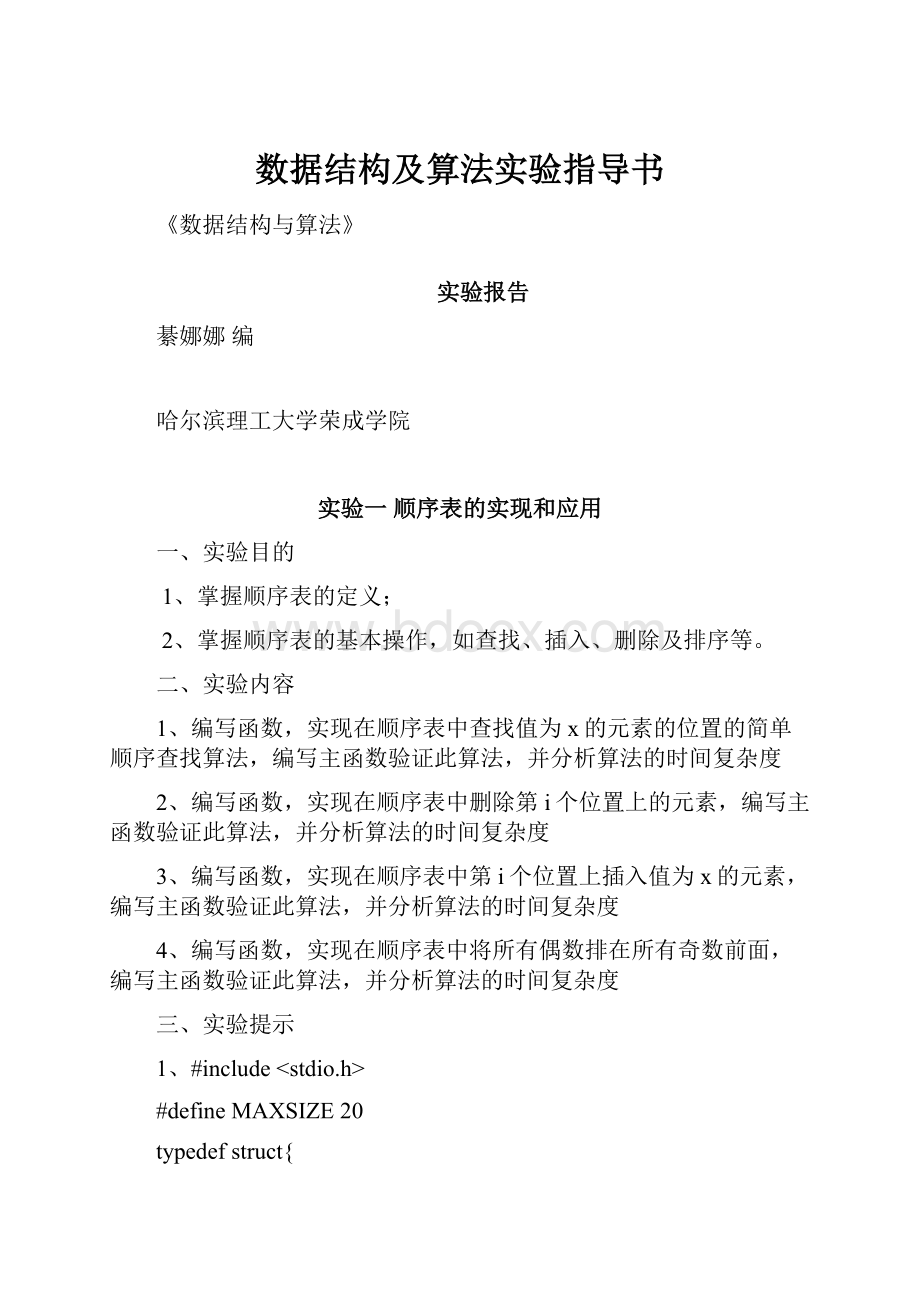数据结构及算法实验指导书.docx
《数据结构及算法实验指导书.docx》由会员分享,可在线阅读,更多相关《数据结构及算法实验指导书.docx(41页珍藏版)》请在冰豆网上搜索。

数据结构及算法实验指导书
《数据结构与算法》
实验报告
綦娜娜编
哈尔滨理工大学荣成学院
实验一顺序表的实现和应用
一、实验目的
1、掌握顺序表的定义;
2、掌握顺序表的基本操作,如查找、插入、删除及排序等。
二、实验内容
1、编写函数,实现在顺序表中查找值为x的元素的位置的简单顺序查找算法,编写主函数验证此算法,并分析算法的时间复杂度
2、编写函数,实现在顺序表中删除第i个位置上的元素,编写主函数验证此算法,并分析算法的时间复杂度
3、编写函数,实现在顺序表中第i个位置上插入值为x的元素,编写主函数验证此算法,并分析算法的时间复杂度
4、编写函数,实现在顺序表中将所有偶数排在所有奇数前面,编写主函数验证此算法,并分析算法的时间复杂度
三、实验提示
1、#include
#defineMAXSIZE20
typedefstruct{
intdata[MAXSIZE];
intlast;
}list;
/*编写函数,实现在顺序表中查找值为x的元素的位置的简单顺序查找算法,编写主函数验证此算法,并分析算法的时间复杂度*/
intlocate(list*l,intx)
{
//代码
inti;
for(i=0;ilast;i++)
if(l->data[i]==x)
returni+1;
return-1;
}
main()
{
listb;
intx,i,p;
b.last=10;
for(i=0;ib.data[i]=i+2;
printf("请输入x的值:
");
scanf("%d",&x);
p=locate(&b,x);
if(p==-1)
printf("no!
");
else
printf("position=%d\n",p);
}
时间复杂度T(n)=O(n);
2、#include
#defineMAXSIZE20
typedefstruct{
intdata[MAXSIZE];
intlast;
}list;
/*编写函数,实现在顺序表中删除第i个位置上的元素,编写主函数验证此算法,并分析算法的时间复杂度*/
intdelete(list*l,inti)
{
intj,k,p;//定义一个用来保存被删原素;
if(i>=0&&ilast)//只接受有效输入
{
for(j=0;jlast;j++)//遍历数组
if(j==i-1)//匹配
{
p=l->data[j];//保存被删原素;
for(k=j;klast;k++)//前进一位;
{
l->data[k]=l->data[k+1];
}
break;//退出循环
}
l->last=l->last-1;
returnp;//对于此题来说可以输出p;
}
return0;
}
main()
{
listb;
intx,i;
b.last=10;
for(i=0;ib.data[i]=i+2;
printf("请输入x的值:
");
scanf("%d",&x);
if(delete(&b,x)!
=0)
{
for(i=0;iprintf("%3d",b.data[i]);
}
else
printf("Error!
");
}
//时间复杂度T(n)=O(n);
3、#include
#defineMAXSIZE20
typedefstruct{
intdata[MAXSIZE];
intlast;
}list;
/*编写函数,实现在顺序表中第i个位置上插入值为x的元素,编写主函数验证此算法,并分析算法的时间复杂度*/
intinsert(list*l,intx,inti)
{
intj,k;
if(i<=l->last+1&&i>0)
{
if(i==l->last+1)//特殊值last+1要插入到整个数组之后
{
l->data[l->last]=x;
}
else
{
for(j=0;jlast;j++)
{
if(j==i-1)//匹配
{
for(k=l->last;k>j;k--)//将所选插入位置之后原素后移
{
l->data[k]=l->data[k-1];
}
l->data[j]=x;//把x赋值给所选位置
break;
}
}
}
l->last=l->last+1;//数值长度加一
return1;
}
return0;//无效位置
}
main()
{
listb;
intx,i;
b.last=10;
for(i=0;ib.data[i]=i+2;
printf("请输入x的值:
");
scanf("%d",&x);
if(insert(&b,66,x)!
=0)
{
for(i=0;iprintf("%3d",b.data[i]);
}
else
printf("Error!
");
}
//时间复杂度T(n)=O(n);
4、
#include
#defineMAXSIZE20
typedefstruct{
intdata[MAXSIZE];
intlast;
}list;
/*编写函数,实现在顺序表中将所有偶数排在所有奇数前面,编写主函数验证此算法,并分析算法的时间复杂度*/
voidfun(list*l)
{//这个代码有点晦涩,但空间时间复杂度是鸡儿低
inti,ou=0,temp;//i计数,ou代表偶数个数
for(i=0;ilast;i++)//循环
{
if(l->data[i]%2==0)//判断是不是偶数,如果是偶数的话和当前第ou个位置的原素交换位置
{
temp=l->data[ou];
l->data[ou]=l->data[i];
l->data[i]=temp;
ou+=1;//偶数个数加一
}
}
printf("当前数组中偶数有%d个,奇数有%d个:
\n",ou,l->last-ou);
}
main()
{
listb;
inti=0,m=0;
b.last=10;
printf("请输入数组元素的值:
\n");
for(i=0;i{
printf("b.data[%d]=",i);
scanf("%d",&b.data[i]);
}
fun(&b);
for(i=0;iprintf("%3d",b.data[i]);
}
//时间复杂度为T(n)=O(n);
四、实验报告要求
1、撰写实验报告;
2、对实验中出现的问题和结果进行总结。
实验二链表的实现和应用
一、实验目的
1、掌握链表的定义;
2、掌握链表的基本操作,如查找、插入、删除、排序等。
二、实验内容
1、单链表的创建
2、单链表的查找
3、单链表的排序
4、单链表的删除
5、链表的应用--约瑟夫环问题
三、实验提示
1、//创建单链表,要求:
结点个数为n个,每个节点数据域的值必须小于m。
编辑主函数验证之。
#include
#include
typedefstructaa
{intdata;
structaa*next;
}NODE;
NODE*Creatlink(intn,intm)
{
inti;
NODE*tou,*p;//tou头结点
tou=(NODE*)malloc(sizeof(NODE));//创建并初始化头结点
tou->next=NULL;
tou->data=n;
printf("请输入%d个小鱼%d的数,中间用空格隔开:
\n",n,m);
for(i=0;i{
p=(NODE*)malloc(sizeof(NODE));
scanf("%d",&p->data);
if(p->data>=m)
{
printf("输入的第%d个数据大于%d,GG\n",i+1,m);
exit(0);//程序强制中断,好像是在头文件stdlib.h里
}
p->next=tou->next;
tou->next=p;
}
returntou;
}
outlink(NODE*h)
{NODE*p;
p=h->next;
printf("\n\nTHELIST:
\n\nHEAD");
while(p)
{printf("->%d",p->data);
p=p->next;
}
printf("\n");
}
main()
{NODE*head;
head=Creatlink(8,22);
outlink(head);
}
2、//查找值为ch的节点在链表中是否出现,如果存在,返回在链表中位序,如果不存在返回0
#include
#include
#defineN8
typedefstructlist
{intdata;
structlist*next;
}SLIST;
SLIST*creatlist(char*);
voidoutlist(SLIST*);
intfun(SLIST*h,charch)
{
inti;
SLIST*p;
p=h->next;//p赋值为寿元节点
for(i=0;i{
if(p->data==ch)
returni+1;
p=p->next;
}
return0;
}
main()
{SLIST*head;intk;charch;
chara[N]={'m','p','g','a','w','x','r','d'};
head=creatlist(a);
outlist(head);
printf("Enteraletter:
");
scanf("%c",&ch);
k=fun(head,ch);
if(k==0)printf("\nNotfound!
\n");
elseprintf("Thesequencenumberis:
%d\n",k);
}
SLIST*creatlist(char*a)
{
inti;
SLIST*tou,*p;
tou=(SLIST*)malloc(sizeof(SLIST));//创建并初始化头结点
tou->data=N;
tou->next=NULL;
for(i=0;i{
p=(SLIST*)malloc(sizeof(SLIST));
p->data=a[i];
p->next=tou->next;
tou->next=p;
}
returntou;
}
voidoutlist(SLIST*h)
{SLIST*p;
p=h->next;
if(p==NULL)printf("\nThelistisNULL!
\n");
else
{printf("\nHead");
do
{printf("->%c",p->data);p=p->next;}
while(p!
=NULL);
printf("->End\n");
}
}
3、//去偶操作,链表中各节点按数据域递增有序链接,函数fun的功能是,删除链表中数据域值相同的节点,使之只保留一个
#include
#include
#defineN8
typedefstructlist
{intdata;
structlist*next;
}SLIST;
voidfun(SLIST*h)
{
SLIST*p,*shanchu;//用于遍历的指针p,用于删除的指针shanchu
p=h->next;/p为寿元节点
while(p->next!
=NULL)//终止条件
{
if(p->data==p->next->data)//判断是否有重复原素
{
shanchu=p->next;
p->next=shanchu->next;
free(shanchu);
}
else
p=p->next;
}
}
SLIST*creatlist(int*a)
{SLIST*h,*p,*q;inti;
h=p=(SLIST*)malloc(sizeof(SLIST));
for(i=0;i{q=(SLIST*)malloc(sizeof(SLIST));
q->data=a[i];p->next=q;p=q;
}
p->next=0;
returnh;
}
voidoutlist(SLIST*h)
{SLIST*p;
p=h->next;
if(p==NULL)printf("\nThelistisNULL!
\n");
else
{printf("\nHead");
do{printf("->%d",p->data);p=p->next;}while(p!
=NULL);
printf("->End\n");
}
}
main()
{SLIST*head;inta[N]={1,2,2,3,4,4,4,5};
head=creatlist(a);
printf("\nThelistbeforedeleting:
\n");outlist(head);
fun(head);
printf("\nThelistafterdeleting:
\n");outlist(head);
}
4、//在main函数中多次调用fun函数,每调用一次fun函数,输出链表尾部节点中的数据,并释放该节点,使得链表缩短。
#include
#include
#defineN8
typedefstructlist
{intdata;
structlist*next;
}SLIST;
voidfun(SLIST*p)
{
SLIST*bianli,*shanchu;//遍历,删除
bianli=p;
while(bianli->next->next!
=NULL)
{
bianli=bianli->next;
}
printf("%d",bianli->next->data);//输出
shanchu=bianli->next;//释放
free(shanchu);
bianli->next=NULL;
}
SLIST*creatlist(int*a)
{SLIST*h,*p,*q;inti;
h=p=(SLIST*)malloc(sizeof(SLIST));
for(i=0;i{q=(SLIST*)malloc(sizeof(SLIST));
q->data=a[i];p->next=q;p=q;
}
p->next=0;
returnh;
}
voidoutlist(SLIST*h)
{SLIST*p;
p=h->next;
if(p==NULL)printf("\nThelistisNULL!
\n");
else
{printf("\nHead");
do{printf("->%d",p->data);p=p->next;}while(p!
=NULL);
printf("->End\n");
}
}
main()
{SLIST*head;
inta[N]={11,12,15,18,19,22,25,29};
head=creatlist(a);
printf("\nOutputfromhead:
\n");outlist(head);
printf("\nOutputfromtail:
\n");
while(head->next!
=NULL){
fun(head);
printf("\n\n");
printf("\nOutputfromheadagain:
\n");outlist(head);
}
}
5、实现约瑟夫环函数(选做)
#include
#include
typedefstructlist
{intdata;
structlist*next;
}SLIST;
SLIST*creatlist(intm)
{
inti;
SLIST*tou,*p,*wei;//头指针生成节点指针尾指针
tou=(SLIST*)malloc(sizeof(SLIST));//头节点
wei=tou;
printf("请输入%d个数用空格隔开:
\n",m);
for(i=0;i{
p=(SLIST*)malloc(sizeof(SLIST));
scanf("%d",&p->data);
wei->next=p;
wei=p;
}
wei->next=tou->next;//令最后一个原素指向首元结点成环
returntou;
}
voidoutlist(SLIST*h,intm,intc)
{
inti;
SLIST*p,*shanchu;//用于遍历的指针p,用于删除的指针shanchu
p=h->next;//p指向首元结点
while(p!
=p->next)//当环中只剩下一个原素时结束
{
for(i=1;i{
p=p->next;
}
shanchu=p->next;//shanchu指向当前要剔除的节点
printf("%d",shanchu->data);
p->next=shanchu->next;//将shanchu指针指向的节点出环
free(shanchu);
p=p->next;
}
printf("%d",p->data);//输出最后的一个节点的内容
free(p);
free(h);
}
main()
{SLIST*head;
intm,c;
printf("请分别输入m和c的值:
");
scanf("%d,%d",&m,&c);
head=creatlist(m);
outlist(head,m,c);
}
四、实验报告要求
1、撰写实验报告;
2、对实验中出现的问题和结果进行总结。
实验三栈的实现和应用
一、实验目的
1、掌握栈的建立方法;
2、掌握栈的基本操作,如入栈、出栈、判断空栈等;
3、栈的应用。
二、实验内容
1、顺序栈的初始化
2、判断栈是否为空
3、顺序栈出栈
4、顺序栈入栈
5、栈的应用--汉诺塔
三、实验提示
1、栈的基本操作,按提示将函数补充完整
#include
#include
#defineSTACK_MAX100
typedefstruct{
inttop;
intdata[STACK_MAX];
}stack;
voidinit(stack*st)/*初始化顺序栈*/
{
st->top=0;
}
intEmpty(stack*st)/*判断栈是否为空*/
{
if(st->top==0)
return0;//空0
else
return1;//非空1
}
intpop(stack*st)/*出栈*/
{
returnst->data[--st->top];
}
voidpush(stack*st,intdata)/*入栈*/
{
st->data[st->top++]=data;
}
intmain(void)
{
stackst;
init(&st);
push(&st,5);
push(&st,6);
printf("%d",pop(&st));
return0;
}
2、#include
voidmain()
{
voidhanoi(intn,charone,chartwo,charthree);
/*对hanoi函数的声明*/
intm;
printf("inputthenumberofdiskes:
");
scanf("%d",&m);
printf("Thesteptomoveing%ddiskes:
\n",m);
hanoi(m,'A','B','C');
}
voidhanoi(intn,charone,chartwo,charthree)
/*定义hanoi函数,将n个盘从one座借助two座,移到three座*/
{
statick=1;//定义静态变量k用来标明走了多少步
voidmove(charx,c